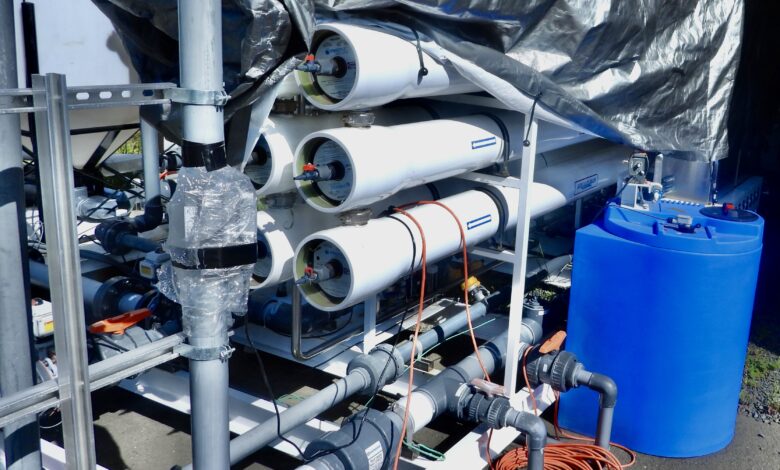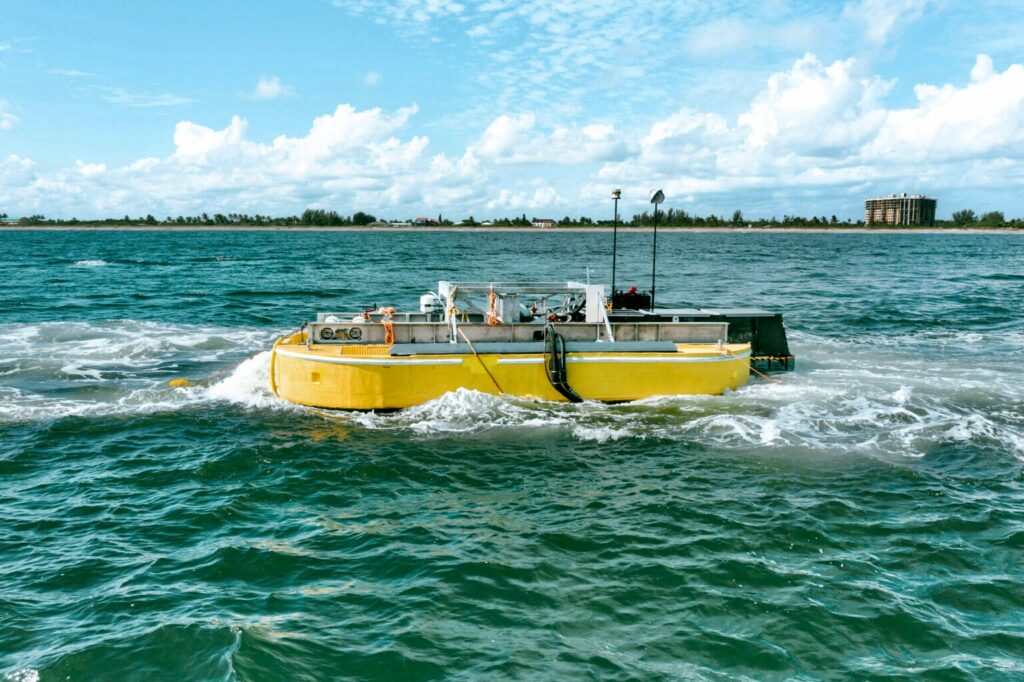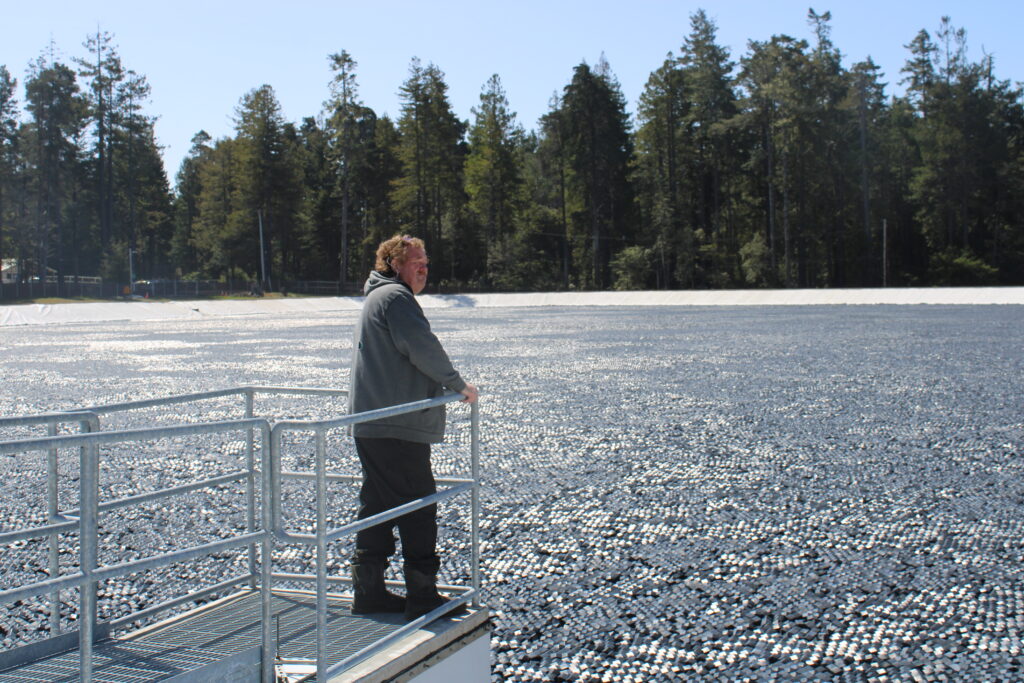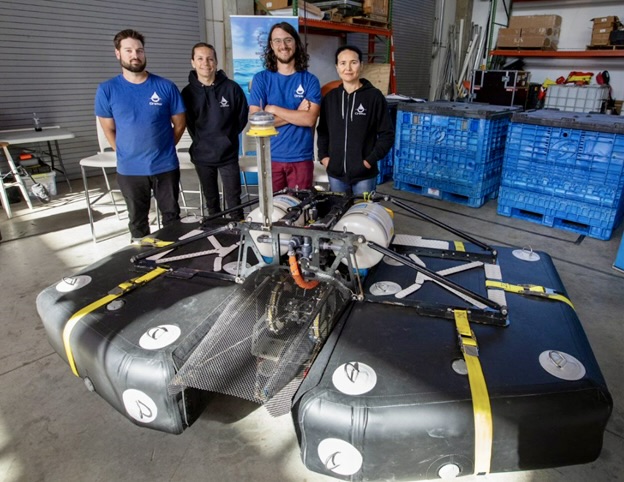ICEBERG!! the wave energy desalinization buoy arrives! As first city in California to try wave energy, Fort Bragg about to step into role as world leader in ocean technology

After three years of refining both engineering and financing, the Oneka wave-powered desalination buoy, called Iceberg has been delivered and will be ready for its test launch in Fort Bragg this week—by its Canadian inventors, here to finalize logistics for the groundbreaking device. Iceberg’s test launch for the media is scheduled for Friday. Write us if you want more information.
Dragan Tutic, founder and CEO of Oneka told the California Coastal Commission this fall that the company was about to deliver the device and told them about Friday’s test launch. The California State Lands Commission issued a two year permit in September.
“What we do is we combine the ocean, sea water and waves to turn it into fresh water just with the motion of the waves. So we’re working together on a 12-month project demonstration to demonstrate this technology, which has the promise of making fresh water with no greenhouse gas emissions, no land use, with the well diluted brine, while also protecting the marine life,” Tutic told the Commission.
“We currently have one unit in Florida and some development in Chile, but the unit that we’re about to deploy in Fort Bragg, once we have the permit, will be shipped to Fort Bragg, soon, and you’re invited to come take a look at it on November 14, where we’ll be exposing the unit during this permitting process before we can deploy it,” Tutic told the Coastal Commission in October.
When it actually launches in 2026, Fort Bragg will join Portugal, Scotland, and Chile in pioneering wave energy—a renewable force with the potential to curb climate change and chip away at global fossil fuel dependence.
That’s the big picture.
Fort Bragg and Oneka Technologies hope to play a very small, but important role in moving a promising but vexing energy source forward.

Wave energy has ancient roots—dating back to the Roman Empire, when tidal motion powered grain mills. Modern large-scale efforts trace back to the Scottish invention known as Salter’s Duck, a wave-powered device praised for its low cost and high efficiency. The Oneka buoy, echoing that legacy, will soon float just beyond view off the Headlands, quietly converting ocean motion into fresh water piped ashore to the city’s sewer plant.
When Oneka executives began scouting locations to test their device, they reached out to major cities—only to hear about a man and a place they’d never expected: John Smith, Fort Bragg’s public works director.
Sure enough, Smith was exactly the kind of partner Oneka had been searching for. The company had submitted its device for study and testing everywhere—from Purdue University in Indiana to the waters off Portugal—and already operates a working buoy in Chile. When the California Coastal Commission convened in Fort Bragg, they praised the collaborative experiment after presentations from Smith and the Oneka team.
That’s when Frank stepped in, writing a story for The Mendocino Voice that laid out the experiment in full. [Read it here.]
Fort Bragg considering wave energy-powered desalination in latest novel water move
Fort Bragg had already earned its reputation as California’s water cowboys—willing to ride any wild water horse to secure the future. In 2016, it became one of the few cities to successfully build a reservoir in the 21st century with the completion of the Summers Lane facility, a project that also boosted instream flows in the Noyo River, benefiting both people and salmon.

But one reservoir wasn’t enough.
Since taking the helm at Public Works, Smith has spearheaded plans for three new reservoirs on 584 acres of former Mendocino Coast Recreation and Parks District land—just east of Summers Lane and north of State Route 20. The city secured grants to fund much of the water infrastructure, including a massive 1.5-million-gallon storage tank. It also purchased a conventionally powered desalination unit to bolster supply.

During the drought, the City installed a Desalination–Reverse Osmosis Treatment System at its water plant, providing a critical lifeline when supplies ran low. (Shown above)
The intense droughts—and the horrifying wildfires that came with them—subsided just as Fort Bragg was gaining momentum in securing its water future. A decade ago, the town faced dangerously short supplies. But the city isn’t easing up, guided by science that charts 150 years of cycles between drought and deluge.
Drought always returns to California—but Fort Bragg has flipped its water story by embracing bold ideas. Councilman Lindy Peters’ long-dismissed desalination dreams are now reality, with two separate efforts underway.
The City constructed a 1.5-million-gallon water tank on Cedar Street—an investment that significantly boosts firefighting capacity across Fort Bragg.
The city would anchor the wave energy buoy offshore of the sewer plant where a pilot study would run for a year. If the pilot study works, a floating array of buoys that look like rafts would be located a half mile offshore, tethered with a special polymer rope, 3 inches in diameter. These would use wave energy to force water sucked in through input screens in a cube below the raft, anchored to the ocean floor, through a reverse osmosis process. Wave energy would power the water to shore near the city sewer plant, where it would be potable water, although possibly requiring some treatment. We will bring more information and photos on Friday. Oneka’s Commercial operations director Camille St-Pierre told us it came earlier in the week and assembly was completed by Wednesday.
In an era of shifting planetary conditions and rising seas, Fort Bragg stands out. The City was one of just three agencies awarded a desalination grant from the Department of Water Resources—and it’s the only one exploring the wave energy–desalination combination. When the device now housed in the city garage launches in 2026, Fort Bragg will be the only California city deploying either wave energy or desalination at sea, let alone both at once.
We’ll bring readers another story soon—after seeing and photographing the device, and speaking with City and Oneka leaders. Below is the permit for the Iceberg device issued by the California State Lands Commission.
City of Fort Bragg (CFB) Oneka Desalination Buoy (Iceberg) Pilot Project Description
The project was deeed exempt from CEQA.
“The pilot project will allow for the collection of empirical data from within California waters that could be used to inform the design and permitting of a future, utility-scale array of Icebergs to augment the CFB water portfolio,” the State Lands Commission report states.
Fort Bragg’s water story is no longer just about survival—it’s about innovation, collaboration, and global leadership. From ancient tides to futuristic buoys, this coastal town is riding the wave of change with grit and vision. As the Oneka device prepares to launch, we’ll be there—documenting the moment, asking questions, and following the current wherever it leads. Stay tuned. The ocean’s next chapter begins here.

